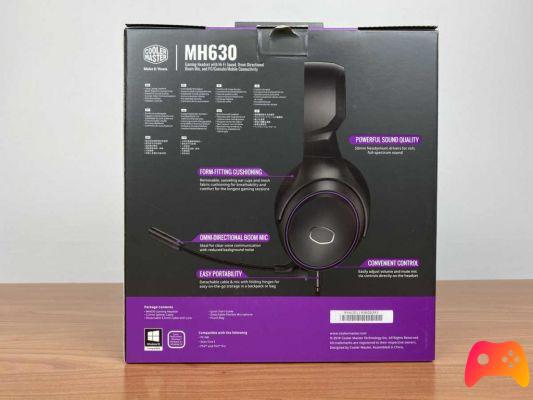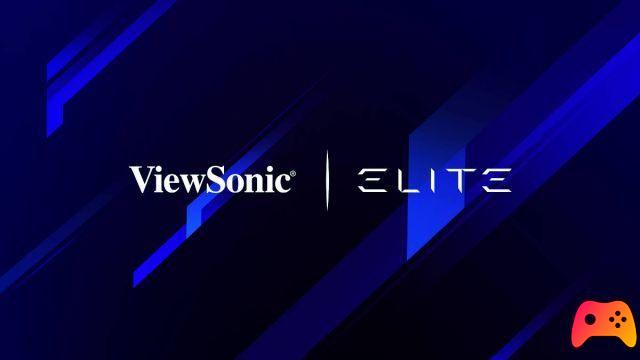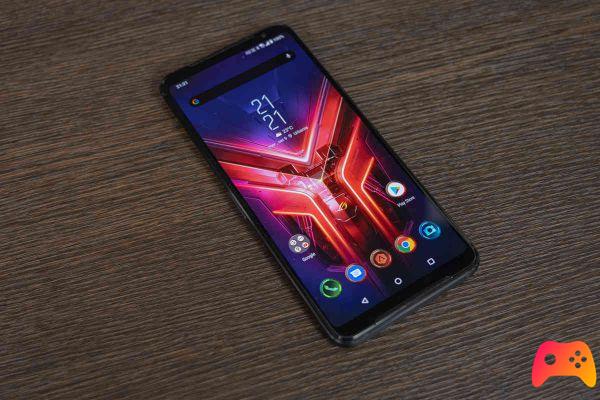
The world of smartphones is now very saturated, there are models for every type of need and budget, but among all these there is a model that stands out from all the others for performance and optimizations on the gaming front. We are obviously talking about ASUS ROG Phone III, the third incarnation of the gaming smartphone according to the Taiwanese house. Asus with this new phone he tried to improve the already excellent ASUS ROG Phone II, introducing several new improvements.
Before talking about the smartphone and our test of use, let's analyze the packaging and its contents.
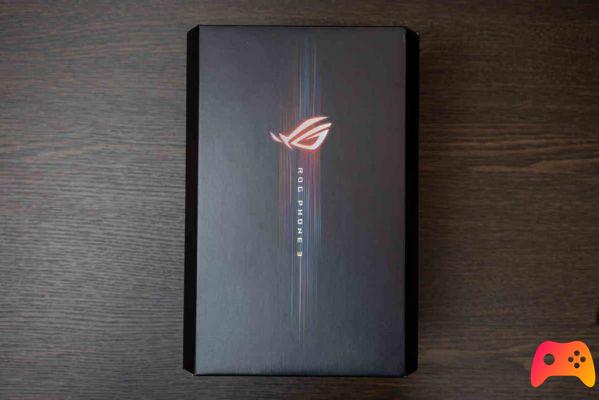
Asus in the products of the ROG line maniacally takes care of any aspect, including packaging. The box with which the ASUS ROG Phone II will be sold is of an irregular hexagonal shape. The coloring is purely black and contains the essence of ROG DNA. Both on the side and at the top of the package we find the iconic red eye.
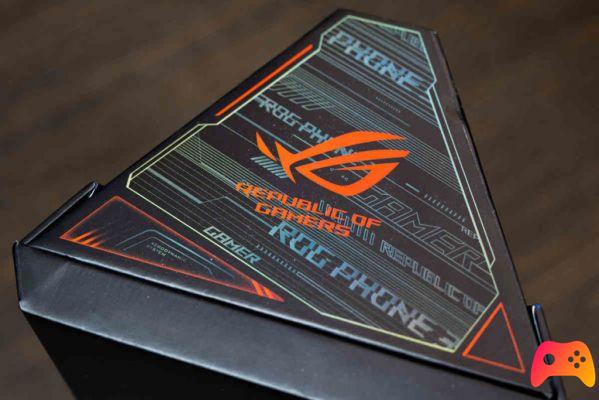
The bundle is truly comprehensive and includes everything we would expect from a phone of this magnitude. In addition to the 2,5A wall charger and the USB - USB Type C cable, we find Active Fan, that is the fan to be placed on the back of Asus ROG Phone III in order to keep it as fresh as possible, an exhaustive instruction manual, the pin to extract the sim compartment trolley and a practical cover which, once inserted, will cover and protect the most delicate parts of the smartphone, without burdening the aesthetic side.
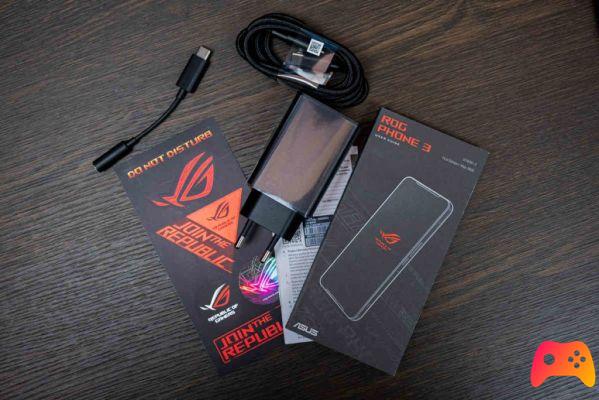
Aesthetically, Asus ROG Phone III is extremely similar to its predecessor, without substantial differences. The front is obviously extremely clean and, in addition to the display, we find two stereo speakers, one on the top and one on the bottom, both covered by a black grille. To the right of the upper speaker we also find the brightness and proximity sensors, the front camera and the sensor for facial recognition, revised and improved compared to the previous model.
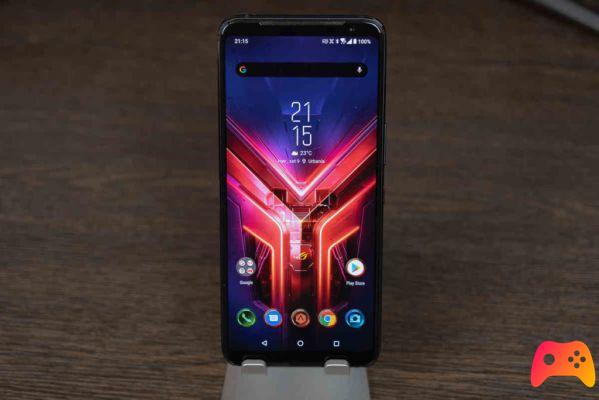
The back embodies all the true essence of ROG DNA. As happened for the previous model, Asus ROG Phone III will be sold in two variants, the more performing and expensive one called simply ROG Phone III, and a cheaper one called ROG Phone III Strix Edition.
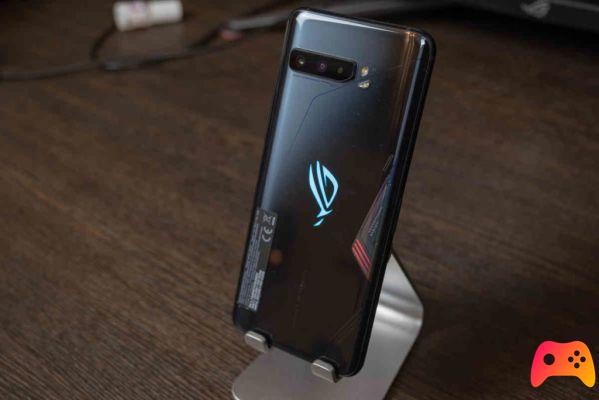
At the center of the rear stands the iconic ROG eye obviously, as it was for the two previous models, equipped with RGB lighting compatible with AURA Sync. Here are also the three cameras, one of 64 Mpx, one of 13 Mpx ultra wide angle and a third of 5 Mpx macro.
On the right side of Asus ROG Phone III we find the volume rocker, the power button and the two Air Triggers, revisited and improved over its predecessor. One of the many microphones that the smartphone is equipped with also finds place.
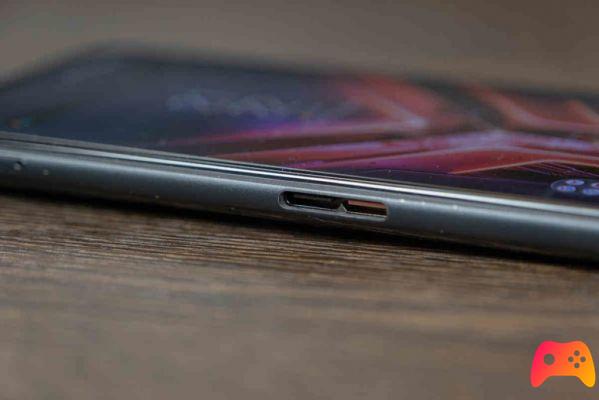
The left side is quite free, here we find only two USB Type-C sockets, one to connect the wall charger and a red one to be used only and exclusively for accessories such as Active Cooler. On this side there is also the sim holder trolley.
On the underside we find only a USB Type-C port, Asus has also decided to remove the audio jack. On the upper side we find nothing, except for one of the three microphones used for the suppression of background noise.
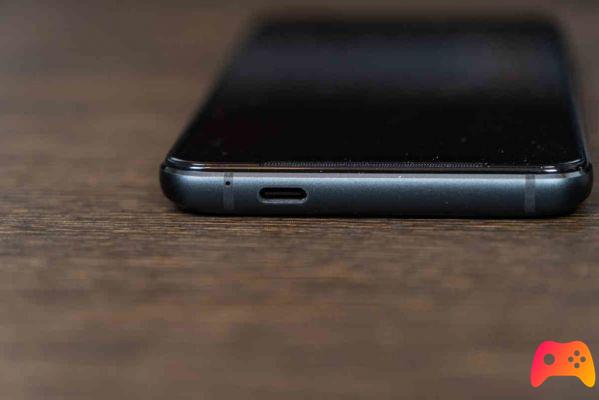
Asus ROG Phone III, as mentioned earlier, takes and takes the concept of gaming on smartphones to the extreme, further improving the already excellent ROG Phone II. The hardware sector is at the forefront in every respect and we find installed the best that the market currently offers. On board we find a Qualcomm Snapdragon 865 Plus with 7nm manufacturing process and eight-core 64-bit processor. Here we find two substantial differences compared to the two versions on the market: ROG Phone III will have a CPU with a 3.1 GHz Clock accompanied by a 5G modem, while the STRIX version will have a slightly lower Clock, 2,84 GHz and will only be able to support LTE networks. The graphics sector is entrusted to the Qualcomm Adreno 650 GPU, able to offer better performance than the previous model, managing to maintain a much more constant average frame rate.
Asus ROG Phone III offers an exaggerated amount of RAM memory, able to run any application without any problem, keeping a large number of processes running in the background. On the ROG Phone III version we find 12 GB of Ram LPDDR5 in its cheapest variant, while we find 16 GB accompanied by 512 GB of Storage, in the top of the range variant. In the STRIX version we find either 8 GB or 12. In terms of connectivity Asus ROG Phone III certainly does not miss anything: in addition to the 5G or LTE + module depending on the version, we also have a Wi-Fi AX module compatible with 2,4 GHz and 5 GHz networks, Bluetooth 5.1 and NFC. At the navigation level we have a GPS module compatible with Glonass, BeiDou, Galileo and QZSS.
The battery offers the same amperage amounts as its previous version ie a capacity of 6000 mAh, able to make us arrive safely at the end of the day even with intense use. If, on the other hand, we dedicate ourselves to gaming, we will be able to play on average for about seven hours: yes, you read that right, even if this figure always depends on the title used. The battery is compatible with the Quick Charge 4.0 charging system, so we can quickly recharge our smartphone and get back to battle immediately.
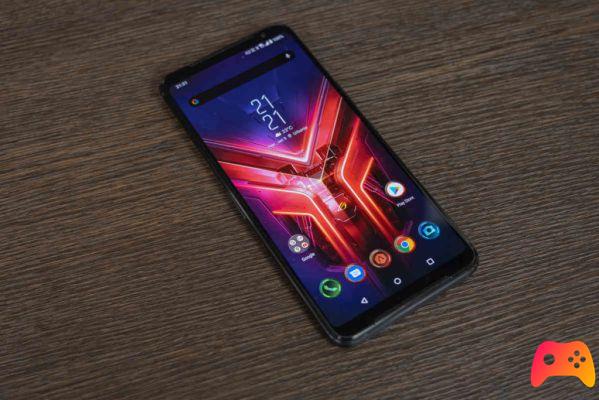
The display installed on Asus ROG Phone II was incredible and here it is even better. We have a type display AMOLED with a diagonal of 6,59 "with a 19.5: 9 ratio, able to return absolute blacks and well-marked contrasts. The contrast ratio is 1.000.000: 1 with a peak brightness of 1000 nits and DCIP3 color gamut support. The resolution is 2340 × 1080 pixels, with a refresh rate of 144 Hz and a response time of only 1 ms. The Asus ROG Phone III display also supports the HDR10 + standard in order to offer more natural colors and contrasts, obviously this will happen in HDR compatible content. The display also offers a Bluelight filter to reduce blue light for eye protection. We also find always-on support in order to always have notifications in view without having to activate the smartphone. The touch panel is capacitive type with 10 touch support and will work even when used with gloves. The glass covering the screen is Corning Gorilla Glass 6, extremely impact resistant, but sensitive to scratches.
Asus ROG Phone III, as you can well guess from the technical characteristics, is an excellent smartphone, as was its predecessor on the other hand. It is able to offer a unique user experience, thanks also to the fantastic display with a refresh rate of 120 Hz. Scrolling a web page, or scrolling the home of Facebook and Instagram, will never be the same: the display manages to give a unique fluidity, difficult to match. Another very important thing, thanks to the high refresh rate of the display, if we use it intensively, is that our eyes will tire less. The CPU, coupled with the excellent GPU and a disproportionate amount of RAM memory, manages to offer excellent performance in every area, whether this is the editing of a video, that of a photo or simple daily use. Asus ROG Phone II was born primarily as a smartphone for gaming, although it has proved extremely versatile in any other use. All the titles we've tried, including Call Of Duty Mobile, PUBG Mobile, Asphalt 8 and 9, had no problem running on our Asus ROG Phone while maintaining a framerate nailed to 60 FPS, even in the most agitated scenes.
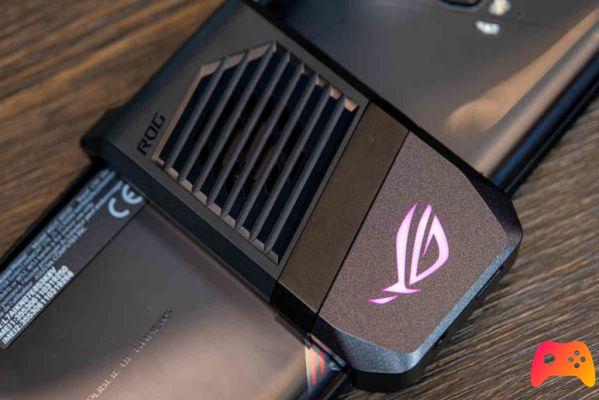
During the intense game phases, however, a note must be made: although the smartphone uses a dissipation system vapor chamber, or steam chamber, tends to heat up a lot in the central rear part. For this reason, the fan that we find inside the package will be very useful. Is called AeroActive Cooler and will be positioned right in the hottest part of the smartphone, so as to quickly dispose of the heat and thus continue to have excellent performance, even after hours of play. The fan takes up the style of Asus ROG Phone III and since, once installed, we will cover the eye on the back of the smartphone, Asus has decided to propose it again here, again with RGB lighting.
To test the capabilities of the Asus ROG Phone III, as well as squeeze it on video games, we also ran some benchmarks, so as to give you a better idea of its potential. The tests are the same as we carried out with Asus ROG Phone, in order to give you a direct comparison. All tests were carried out using the X mode, thus taking advantage of the maximum performance of the smartphone.
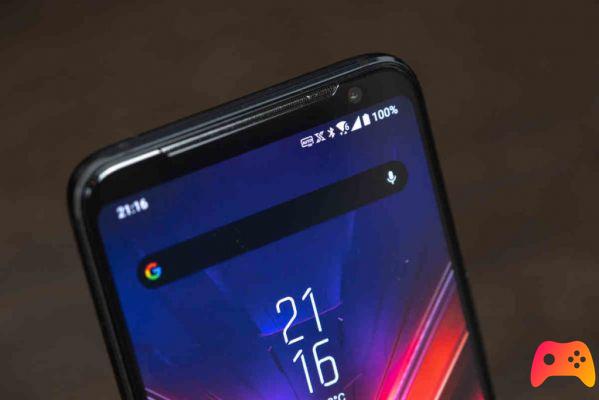
The first benchmark we used was the 3D Mark Mobile suite, using the Extreme preset and taking advantage of both the OpenGL and Vulkan libraries. In the table below we can immediately see that, in terms of benchmarks, Asus ROG Phone III is clearly superior to its predecessor.
| Asus ROG Phone III | Asus ROG Phone II | Asus ROG Phone | |
|---|---|---|---|
| Open GL - Total Score | 7706 | 6243 | 4546 |
| Open GL - Graphics Score | 9097 | 7058 | 5147 |
| Open GL - Physix Score | 5020 | 4445 | 2301 |
| Vulkan - Total Score | 6853 | 5440 | 3920 |
| Vulkan - Graphics Score | 8758 | 6482 | 4906 |
| Vulkan Physix Score | 3891 | 3481 | 2301 |
The second benchmark is the most popular on mobile, because it is compatible with both Android and iOS, or AnTuTu Benchmark. Here, too, we can immediately notice the clear difference that exists between the second incarnation of Asus' gaming smartphone and its first version.
| Asus ROG Phone III | Asus ROG Phone II | Asus ROG Phone | |
|---|---|---|---|
| total Score | 646310 | 395970 | 279696 |
| CPU Score | 183149 | 129152 | 80700 |
| GPU Score | 247933 | 168912 | 126913 |
| User Experience Score | 104010 | 81661 | 58310 |
| Memory Score | 111240 | 16245 | 13773 |
The last benchmark used was GeekBench, another well-known test available both on mobile, then Android and iOS, and on Desktop, then Linux, Windows and Mac. In single core Asus ROG Phone III managed to get a score of 923, while in multi core of 3310.
The smartphone will no longer have the fingerprint sensor on the back, but rather below the display. Although it is a not indifferent novelty, the unlocking with fingerprints turns out to be slightly slower than that of its predecessor, but despite this it works very well and we have never had problems during the unlocking. As for the predecessor, Asus ROG Phone III also supports unlocking with facial recognition, revised, improved and extremely fast, on par and in some conditions faster than Apple's Face Id and also ungrateful to recognize us with the mask on.
During our tests we also used Asus ROG Phone III as a navigator. The GPS immediately hooks up to the satellite in order to give us our position almost instantly in a radius of about 1 meter, this obviously when we are outdoors. In closed rooms the range of action will be greater, but it remains quite accurate, unless we are underground, there no smartphone would be able to locate our position. The compass works very well and during our tests we never had to resort to calibration. Certainly with the latest smartphone from ROG you will hardly get lost.
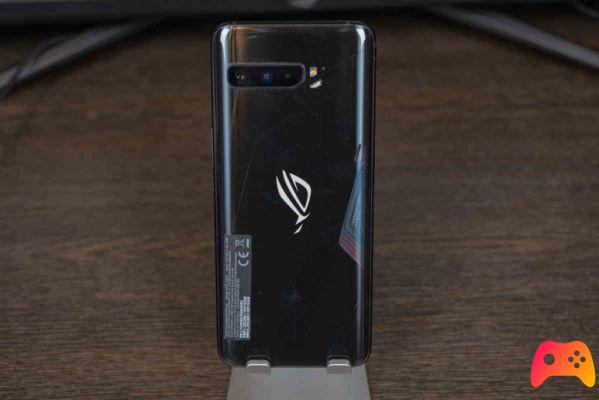
Asus with ROG Phone III has tried to propose a better photographic sector than its predecessor. The main rear camera has a 686/1 ″ and 7 megapixel Sony IMX16 flagship sensor which, thanks to Quad Bayer technology, is capable of capturing photographs up to 64 Mpx resolution. The size of each single pixel is around 0,8 μm. The focal aperture is 1.8, with a maximum length of 26,6mm, the equivalent of a 35mm camera. The camera's field of view is 79 °. The main camera of Asus ROG Phone III is equipped with autofocus that can focus the image in just 0,003 seconds.
The secondary camera is always wide-angle, mounts a 13 Mpx sensor. It will be possible to take photos or videos with a viewing angle of 125 ° and a focal aperture of F2.4. The wide-angle camera allows us to have a 200% wider view. As with the predecessor, here too we can instantly switch between the two sensors, then switch from the main camera to the wide-angle one at any time and at our complete discretion.
Finally, we have a third 5 Mpx sensor with F2.0 aperture, capable of making us take macro photos.
The front camera has also been revised, so as to make us look even more beautiful during our selfies. Asus has in fact inserted a 24 megapixel sensor with a focal aperture of 2.0 and a focal length comparable to that of a 27 mm. The field of view is similar to that of the main rear sensor, approximately 78 °. The photo capture software has remained virtually unchanged. Both the rear and front cameras have different filters, in order to make our photos even more beautiful and unique. We also find the HDR mode and the manual mode with the ability to save photos even in RAW format and without any compression.
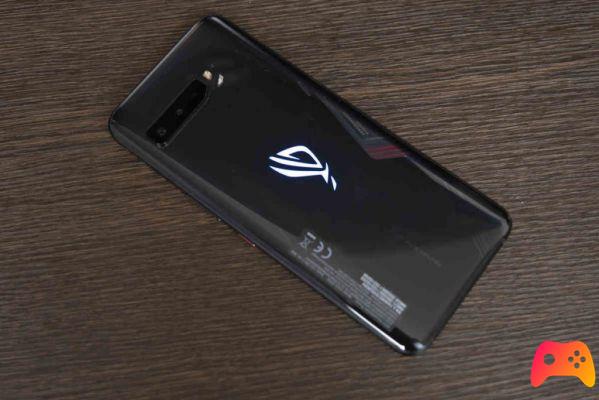
The acquisition methods are the same as in the first version. The rear camera will be able to record video at a maximum resolution of 8K at 30 FPS, and then drop to 4K at both 30, 60 and 120 frames per second, while the front camera stops at Full HD 30/60 FPS resolution.
Asus ROG Phone III is natively equipped with Android 10. The graphical interface is similar to that of ROG Phone II, only now, during the initialization phase, we can choose whether to adopt the Zen UI interface or keep the ROG one. This operation will obviously also be possible at a later time. The user experience of the launcher is very similar to that of stock Android. Here too we find the "Game Center" application, revisited and improved, where we can monitor practically everything: CPU and GPU clock speeds with their relative temperatures, available storage, create customized profiles for video games, rear fan, enable the overlay with the information on the screen, start the games, create special profiles and activate the X mode During the game phases, by swiping from left to right, we can recall the main Game Center functions.
The X mode will increase the performance of our smartphone, enabling overclocking and bringing the maximum CPU frequency up to 3,1 GHz. When we enable it, the eye on the back will light up and the icons and background of the desktop will change color, tinged with red. From Game Center it will also be possible to connect to your Facebook, Twitch and Youtube profiles, in order to perform live broadcasts of our games directly from your smartphone.
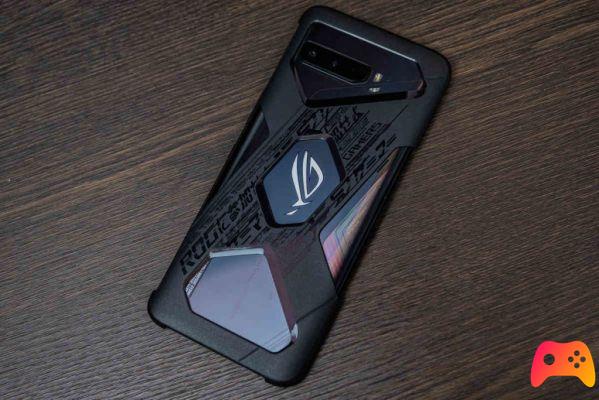
Asus ROG Phone III really amazed us and was able to improve on its already great predecessor. A powerful smartphone in all, with a dizzying battery, able to accompany us for two days without any problem, a graphics sector worthy of the name and the ROG DNA to embellish everything. Asus ROG Phone III is a top-of-the-range smartphone and is able to perform any task excellently. The 120 Hz display is also able to make the user experience unique.
If you want a great phone that can give you an excellent user experience and that is able to run any application at its best, Asus ROG Phone III could be for you and you can buy it for the price of 999 €.




